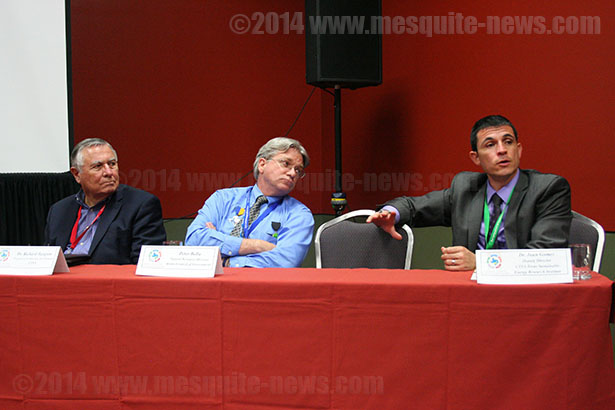
By Rebecca Salinas
Rapid growth in the Eagle Ford Shale has pumped more pollutants into the South Texas air and overwhelmed rural communities.
Peter Bella, natural resource director for the Alamo Area Council of Governments, and three other panelists discussed these and related issues at the Eagle Ford Consortium Conference last week.
Dr. Juan Gomez, deputy director of the UTSA Texas Sustainable Energy Research Institute and Dr. Richard Tangum, professor of architecture and planning at the University of Texas at San Antonio, agree inadequate infrastructure challenges the Eagle Ford Shale region.
Consortium’s Impact
Scott Storment, executive director of the Mission Verde Alliance, moderated the “Issues and Demand to Infrastructure in the Eagle Ford Region” session at the Eagle Ford Shale Consortium Conference.
After attending many conferences dealing with economic and environmental sustainability, Storment says the impact of the conference will take time to measure.
“The impact that they (conferences) make is that they keep the dialogue open about what should be happening, what could be happening, what would be positive movement by the industry,” Storment said in an interview Wednesday.
The annual Conference titled, “Driving the 21st Century Texas Economy: Sustainable Oil & Gas Communities,” attracted oil and gas industry stakeholders to its meeting April 21-23.
Seven hundred guests attended the conference with more than 100 speakers at the Henry B. Gonzalez Convention Center downtown.
Though just three years old, the consortium brings together panelists to help “foster effective lines of communication,” especially since activity in the Eagle Ford Shale will increase.
Storment said every conference and conversation advances thinking and practices. Companies think about technical advancements and their direct impact on the communities, and local governments become smarter and better prepared.
“Where we are now, is definitely a better place than where we were two years ago with the Eagle Ford,” he said. “Two years is a fast movement. They (rural cities) have been the same way for 50-60 years and they haven’t changed, and now they’re having to change because they have to be a big boy or big girl.”
Rural Impact
The Eagle Ford consists of a shale rock formation in South Texas, where more than 5,600 oil and 2,700 gas rigs operate every day. The region consists of 20,000 square miles, but population varies considerably over the region.
Most of the challenges lie in rural towns because they do not have adequate resources, Storment said. Also, the lesser-populated counties tend to produce the most oil and gas.
Storment said conference guests should use what they learned as a springboard to advance knowledge.
The conference provided a general overview of the shale’s impact, but talking about it within local communities leads to specific opportunities.
“Many of those folks don’t have resources, they don’t know exactly where to go, so they attend these conferences and they learn a lot,” he said.
Environmental Impact
The session addressed the industry’s impact on the atmosphere.
Bella explained the industrial activity increased volatile organic compounds, or VOC, and Nitrogen oxides, or NOx, which combine to create ozone. High ozone levels create a health risk.
Production of NOx has decreased over the last few years due to gas and technology enhancements, he said.
“There will be necessary effects from Eagle Ford into the region. The question is: How much and how can they be controlled,” he said.
Storment said once San Antonio reaches a dangerous ozone levels, the Environmental Protection Agency gets involved and “they become the puppeteer.”
“The cost to fix the problem after it’s here is going to be much greater,” he said. He urges people to become educated about the ozone problems now.
Gomez agreed, saying the community needs to educate itself on how it uses water, air and food daily.
“Do we want to be proactive or reactive?” Gomez asked. “If we spread the risk…across the region, we are able to do much more innovative stuff.”
“Air doesn’t respect boundaries. Sewer, water, doesn’t either. Energy doesn’t either,” he said.
Rapid work and population growth creates a need for housing, restaurants and health care facilities.
Rapid urbanization has hit small towns, Gomez said, as people shoehorn into those communities in the shale. But, adequate infrastructure does not exist in those areas because builders do not pay much attention to those areas.
“Now all of a sudden you have a big move, you need all these resources back in the rural areas,” he said.
Water Issues
The demand for water also stirs concern in South Texas.
Gomez said an oil well may not take much water, but the workers need water for daily living.
He said it takes about 4-5 million gallons for a hydraulic fracturing well. A person can use anywhere from 50 to 200 gallons of water per day.
He added the biggest water users are the people who receive water at a low price, or pay nothing at all, like people in rural areas.
“Because you pay very little, all of a sudden you value it much less,” he said.
The water deficit expected in Austin and San Antonio makes the water issue prominent. Gomez added people forget about the tough drought Texas went through, and the value of the water supply.
One solution is to desalinate brackish water, water high in saline, or sea water.
Gomez said the fact that Texas has no seawater desalination plants in the state disappoints him because the state has not tapped in to seawater as a resource yet.
“We are now in a place where we have to look at everything,” he said. “The future is going to force cities, communities to do a little bit of everything.”
Bella agreed conversation and experimentation need to take place first, then implementation can happen.
Gomez said, “At the end of the day, you need those resources. We take all those services that are very basic and very necessary for granted.”
Housing Concerns
The Eagle Ford region also faces a lack of housing for oil field workers.
Architects look at strategic plans, available resources and goals, while the community as a whole makes the basic decisions. When discovered, vision designs, site plans, and development designs are created.
Tangum said planning starts when oil pad locations are mapped out, then comes the planning for infrastructure and transportation.
“The land use pattern also impacts, substantially, the transportation network,” he said.
Apart from the infrastructure, Tangum stressed the importance for communities to maintain their character to preserve or enhance their history and culture.
“How do we involve strategies to get to that desired future in the best way possible?” he asked.
When planning, Tangum said developers should consider the real-estate market, road traffic, sewer systems and water supply. At the same time, the local governments need to understand the magnitude of the situation.
Right now, the oil boom’s effects overwhelm governments in small towns.
The panelists agreed thorough planning avoids problems like this.
Tangum said developers and architects should use Geographic Information Systems, or GIS, a computer system designed to capture, analyze and present all types of geographical data. Satellite imagery, the U.S. Census and the Railroad Commission compile information to view land use.
“We can visualize. We can then show the information to the stakeholders and the community so they can understand what it is all about,” Tangum said.
While industry leaders and architects develop the infrastructure, the community needs to plan and prepare for it as well.
Bella said, “The growth of this community — the growth of this industry doesn’t mean that we’re making greater pollution. Find a way to make reductions. We’ve got to be able to say, ‘The health risks are as important than the economic growth, so let’s find a way to piece them all together.’”
The panelists agreed industry workers and communities need to understand the magnitude of the situation, and allow moderate growth to keep things under control.
Gomez said industry leaders and engineers believe innovation and technology can solve the region’s transportation, air emission, and water problems, but they should not have to deal with the problems.
“We’ve done an amazing job technology wide…but those efficiency improvements are being negated by the type of growth that we are seeing, by how fast we are growing,” he said.
Bella stressed the importance for the oil field workers to invest in education to build a solid infrastructure and provide staying power and value to the citizens.
“I would argue as far as building sustainable, profitable futures, education is probably at the very top of the list,” Bella said.






